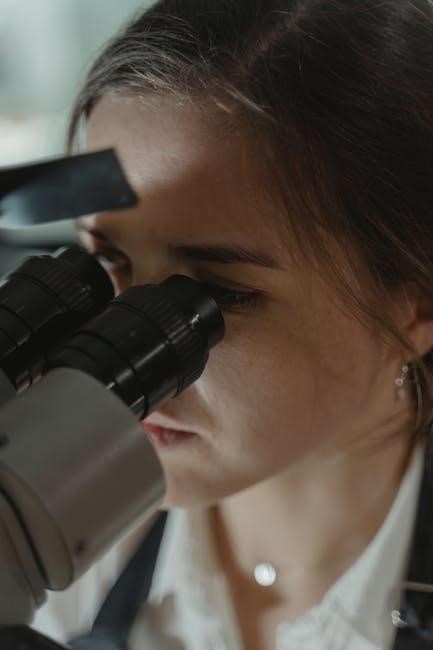Cell Structure and Function
Understand the cell membrane’s structure, including the fluid mosaic model, glycolipids, and glycoproteins. Learn about cellular organelles like the nucleus, mitochondria, ribosomes, and their functions. Study active and passive transport mechanisms for cell membrane permeability.
- Define the roles of lysosomes, endoplasmic reticulum, and Golgi apparatus.
- Explain how cells specialize and communicate through signaling molecules.
Master these concepts for a strong foundation in cellular biology.
1.1 Cell Membrane and Transport
The cell membrane, also known as the plasma membrane, is a thin, semi-permeable structure composed of a phospholipid bilayer with embedded proteins. It regulates the movement of materials in and out of the cell through passive transport (e.g., diffusion, osmosis) and active transport, which requires energy. Key concepts include the fluid mosaic model, glycolipids, and glycoproteins. Understand how substances like oxygen, glucose, and ions are transported across the membrane. Be familiar with examples of each transport type and their biological importance. This section is critical for understanding cellular function and homeostasis.
- Passive transport: No energy required (e.g., diffusion, osmosis).
- Active transport: Energy required (e.g., sodium-potassium pump).
Mastering these concepts is essential for the midterm exam.
1.2 Cellular Organelles and Their Functions
Cellular organelles are specialized structures within cells that perform specific functions essential for survival. The nucleus houses DNA, controlling genetic activities. Mitochondria generate ATP through cellular respiration, serving as the cell’s energy hub. Ribosomes synthesize proteins, vital for growth and repair. The endoplasmic reticulum processes proteins and lipids, while the Golgi apparatus modifies and distributes them. Lysosomes contain digestive enzymes, breaking down waste and foreign substances. The cytoskeleton provides structural support and aids in cell movement. Each organelle works together to maintain cellular homeostasis and ensure proper function.
- Nucleus: Genetic control center.
- Mitochondria: Energy production.
- Ribosomes: Protein synthesis.
Understanding organelle roles is crucial for grasping cellular biology.

1.3 Cell Specialization and Communication
Cell specialization occurs as cells differentiate into specific types, such as nerve or muscle cells, to perform unique functions. This process is guided by gene expression, where only certain genes are active. Communication between cells is vital for coordination and responses to stimuli. Cells communicate through direct contact, signaling molecules like hormones, or gap junctions. These interactions regulate processes like growth, immune responses, and tissue repair. Understanding how cells specialize and communicate is essential for grasping tissue and organ functions in complex organisms.
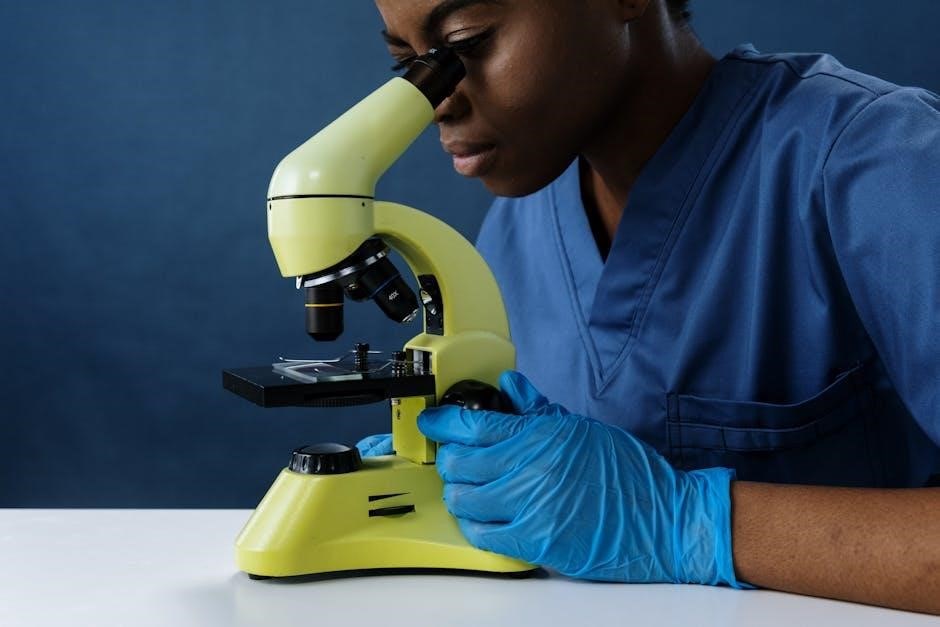
- Specialization: Cells adapt to specific roles.
- Communication: Essential for coordinated responses.
Mastering these concepts enhances understanding of cellular interactions and biological systems.

Biological Molecules
Focus on carbohydrates, proteins, lipids, and nucleic acids. Understand their structures, functions, and roles in biological systems. Key concepts include polymer formation and biochemical importance.

2.1 Carbohydrates, Proteins, and Lipids
Carbohydrates are energy-rich molecules, such as sugars and starches, serving as the body’s primary energy source. Proteins, composed of amino acids, function as enzymes, hormones, and structural components. Lipids, including fats and sterols, are crucial for cell membrane formation and hormone production. Understand the monomer-polymer relationship: monosaccharides form carbohydrates, amino acids form proteins, and fatty acids form lipids. Key functions include energy storage, catalyzing reactions, and maintaining cellular integrity. Recognize examples like glucose, insulin, and cholesterol. These biomolecules are essential for life, supporting metabolic processes, growth, and cellular repair.
- Carbohydrates: Energy storage and transport (e.g., glucose, cellulose).
- Proteins: Structural support, enzymes, and signaling (e.g., hemoglobin, amylase).
- Lipids: Membrane structure, signaling, and energy storage (e.g., phospholipids, cholesterol).
2.2 Nucleic Acids and Their Role in Genetics
Nucleic acids, DNA and RNA, store and transmit genetic information. DNA is a double-stranded helix, while RNA is single-stranded. Both are composed of nucleotides containing a sugar, phosphate, and nitrogenous base. DNA replication ensures genetic continuity, while transcription produces RNA from DNA. Translation uses mRNA to synthesize proteins, guided by tRNA and ribosomes. Key concepts include base pairing rules (A-T, C-G in DNA; A-U in RNA) and the central dogma. Understand genetic variations like mutations and crossing over, which drive evolution and inheritance; These processes are vital for gene expression, heredity, and biodiversity.
- DNA: Double helix structure, replication, and genetic storage.
- RNA: Roles in transcription, translation, and protein synthesis.
- Genetic code: Universal base pairing and amino acid encoding.
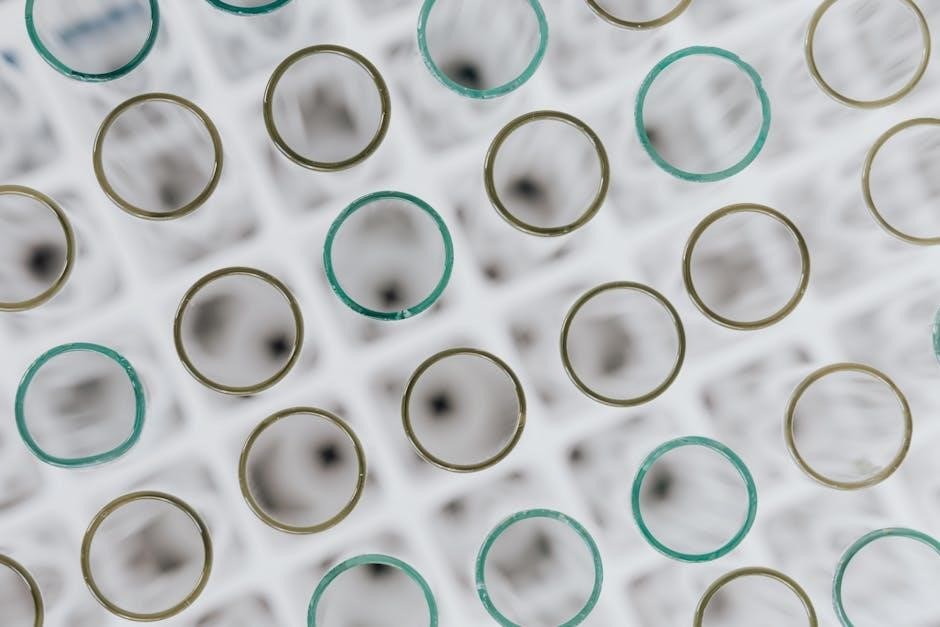
Energy Processes in Biology
Explore photosynthesis and cellular respiration, focusing on energy conversion, ATP production, and the role of mitochondria. Understand the light-dependent and Calvin cycles in photosynthesis.
- ATP: Central energy carrier in cells.
- Photosynthesis equation: 6CO₂ + 6H₂O → C₆H₁₂O₆ + 6O₂.
- Cellular respiration equation: C₆H₁₂O₆ + 6O₂ → 6CO₂ + 6H₂O + ATP.
3.1 Photosynthesis and Its Importance
Photosynthesis is a vital process where plants, algae, and some bacteria convert light energy into chemical energy. It occurs in chloroplasts and involves chlorophyll, the green pigment. The process has two stages: the light-dependent reactions and the Calvin cycle. In the light-dependent stage, water is split to produce ATP and NADPH. The Calvin cycle uses these molecules to fix CO₂ into glucose, releasing oxygen as a byproduct. Photosynthesis is essential for producing oxygen and organic molecules, supporting life on Earth. It also forms the base of food chains and regulates Earth’s climate by removing CO₂. Understanding its mechanisms is crucial for biology exams.
- Key equation: 6CO₂ + 6H₂O → C₆H₁₂O₆ + 6O₂.
- Chlorophyll absorbs light energy, driving the process.
- ATP and NADPH are energy-rich molecules.
3.2 Cellular Respiration and ATP Production
Cellular respiration is a metabolic process that converts glucose into energy (ATP). It occurs in three stages: glycolysis, the Krebs cycle, and the electron transport chain. Glycolysis breaks glucose into pyruvate, producing 2 ATP. The Krebs cycle converts pyruvate into acetyl-CoA, generating 2 ATP and NADH/FADH₂. The electron transport chain uses these molecules to produce up to 32-34 ATP through oxidative phosphorylation. Oxygen is the final electron acceptor, making cellular respiration an aerobic process. Total ATP yield per glucose is 36-38 ATP. This process is vital for energy production in cells, supporting life and cellular functions.
- Glycolysis occurs in the cytoplasm.
- Krebs cycle and electron transport chain occur in mitochondria.

Homeostasis and Regulation
Understand the immune system’s role in defending against pathogens and producing antibodies. Explore the nervous system’s function in neurotransmission and hormone regulation to maintain homeostasis.
- Immune system: Recognizes and neutralizes threats.
- Nervous system: Controls bodily functions and responses.
- Learn the structure and function of neurons and synapses.
- Understand how hormones interact with target cells.
- Explore feedback mechanisms in hormone regulation.
- Analyze how ecosystems maintain balance and respond to changes.
4.1 The Immune System and Its Functions
The immune system is a complex defense mechanism protecting the body from pathogens, infections, and diseases. It consists of two main components: innate immunity, which provides immediate, non-specific protection, and adaptive immunity, offering specific, long-term defense. Key functions include recognizing pathogens, producing antibodies, and maintaining homeostasis. Understanding how immune cells like T-cells and B-cells function is crucial. The immune system also interacts with other bodily systems, such as the nervous and endocrine systems, to regulate responses. This section covers the roles of organs like the spleen and lymph nodes, as well as the importance of vaccines in enhancing immune memory.
4.2 The Nervous System and Hormone Regulation
The nervous system controls voluntary and involuntary actions, while the endocrine system regulates bodily functions through hormones. The hypothalamus and pituitary gland are key in hormone regulation, influencing processes like growth and metabolism. Understand how neurons transmit signals and how hormones like insulin and adrenaline maintain homeostasis. Study the roles of the central and peripheral nervous systems, including reflexes and sensory responses.
Mastering these concepts is essential for understanding how the body responds to internal and external changes.
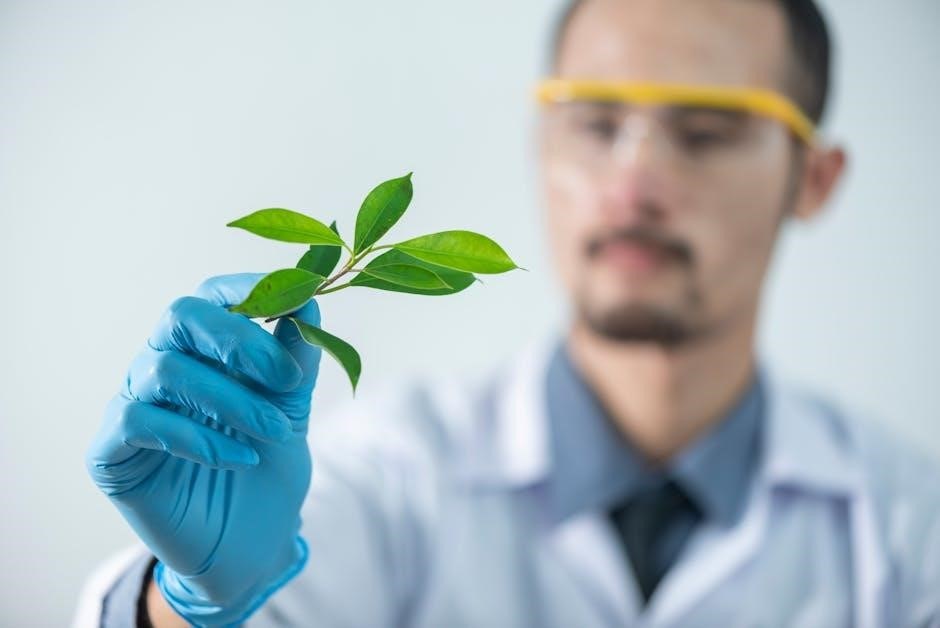
Ecosystems and Interactions
Study energy flow through ecosystems, food webs, and trophic levels. Understand roles of producers, consumers, and decomposers. Explore interactions like predation, competition, and symbiosis. Learn nutrient cycles and biodiversity importance.
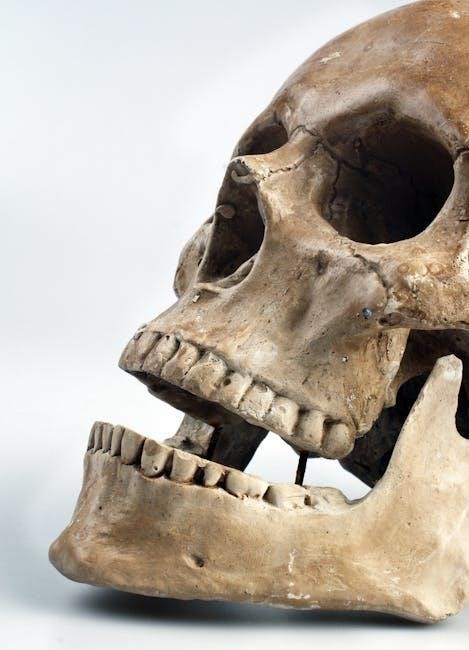
Focus on key processes like carbon and nitrogen cycles for a strong grasp of ecological principles.
5.1 Food Webs and Energy Flow
Understand the structure of food webs, which illustrate energy flow through ecosystems. Producers, like plants, form the base, converting sunlight into energy via photosynthesis. Herbivores eat producers, while carnivores consume herbivores or other carnivores. Decomposers break down organic matter, recycling nutrients. Energy flows unidirectionally through trophic levels, with only 10% transferring to the next level due to heat loss and metabolic costs. Key concepts include predator-prey relationships, symbiosis, and keystone species. Analyze how disturbances, like invasive species, impact food webs. Study examples, such as grass → insect → bird, to grasp energy flow dynamics. This understanding is vital for comprehending ecosystem balance and stability.
5.2 Decomposers and Nutrient Cycles
Decomposers, such as bacteria and fungi, break down dead organisms, recycling nutrients like carbon, nitrogen, and phosphorus. These cycles sustain life by returning nutrients to producers, enabling photosynthesis and energy flow. Decomposers release minerals into the soil, promoting plant growth and maintaining ecosystem balance. Without them, nutrients would remain locked in organic matter, halting energy transfer. Study the carbon cycle, nitrogen fixation, and nutrient cycling processes. Understand how decomposers link producers and consumers, ensuring resource availability. Focus on how disturbances, like decomposition rate changes, affect nutrient availability and ecosystem health; Mastering these cycles is essential for grasping ecosystem functioning and energy flow dynamics.

Study Tips and Exam Preparation
Set a study schedule, use active learning techniques, practice with past exam questions, utilize flashcards, and attend review sessions to ensure thorough preparation.
6.1 Active Learning Techniques for Biology
Engage with biology concepts through self-quizzing, flashcards, and summarizing notes. Teach complex topics to others to reinforce understanding. Participate in study groups to discuss challenging questions actively. Use concept maps to visualize relationships between biological processes. Apply knowledge by solving practical problems or analyzing case studies. Take breaks to avoid burnout. Reflect on mistakes and review them regularly. Watch educational videos or animations to supplement textbook learning. Practice labeling diagrams to master structures like cells or organelles. Use mnemonics to remember key terms. Stay organized and track progress to identify weak areas early. Active learning enhances retention and comprehension.
6.2 Practicing with Past Exam Questions
Practicing with past exam questions is crucial for midterm preparation. It helps familiarize yourself with the exam format, timing, and question types. Start by attempting questions without aids to assess your current knowledge. Review answers to understand mistakes and focus on weak areas. Use flashcards for challenging topics and regularly test yourself. Time your practice sessions to build exam-day stamina. Organize questions by topic to target specific areas needing improvement. Analyze common themes and high-weight topics from past papers. Regular practice enhances problem-solving skills and boosts confidence. Stay consistent and track progress to ensure readiness for the midterm exam.
6.3 Using Flashcards for Vocabulary Mastery
Flashcards are an effective tool for mastering biology vocabulary and concepts. Write key terms on one side and definitions or explanations on the other. Review them regularly, focusing on weak areas. Use digital flashcard apps like Quizlet for convenience and spaced repetition. Test yourself actively by recalling information without peeking. Organize flashcards by topic to streamline study sessions. Include diagrams or mnemonics for complex concepts. Track progress to identify gaps in knowledge. Consistent use of flashcards enhances retention and ensures familiarity with essential terminology. This method is ideal for active learning and last-minute review before the midterm exam;
6.4 Recommended Resources for Last-Minute Review
Utilize reliable resources for efficient last-minute review. Textbooks and online study guides provide concise summaries of key concepts. Websites like Khan Academy, Quizlet, and Coursera offer video tutorials, flashcards, and practice quizzes. Review past exams to familiarize yourself with question formats. Flashcard apps like Anki and Quizlet help memorize vocabulary and processes. YouTube channels dedicated to biology, such as Crash Course Biology, present complex topics in an engaging manner. Additionally, join study groups or forums to discuss challenging topics with peers. Prioritize resources that align with your curriculum and track your progress to ensure comprehensive preparation. These tools will help you maximize your final review sessions effectively.
